
The southern copperhead, Agkistrodon contortrix is a beautiful snake, with a pattern of scales whose colors give it its name. But it’s also venomous and needs to be removed if it’s found in the home. This needs to be done by a professional.
About the Copperhead
The southern copperhead can be found from the Florida panhandle to Texas in the south and north into southern New England. It is a type of pit viper, which means it has two pits in its face that are used as special sense organs. Specifically, they detect the heat given off by potential prey.The facial pits in a copperhead snake are found between its eyes and its nostrils, and some people mistake these pits for the snake’s nostrils. Each pit has a large cavity the front with an opening into the snake’s nose. Because the copperhead has two pits on either side of its face, it can use its heat sense to judge distances with great accuracy. The pits are even more helpful when one considers that the copperhead is a cold-blooded animal looking for warm-blooded prey.
The copperhead is found in forests, near swamps, in open woodlands, in caves, logs, tree stumps, abandoned mines, construction sites, and near rivers. Because it often lives around humans, the copperhead is famous for the high number of bites it delivers. Fortunately, its venom is mild compared to the venom of snakes such as the coral snake.
What It Looks Like
The copperhead has a reddish-brown body with patterns of copper and shades of brown. Young copperheads are gray, and the tip of the tail is yellow until it’s three or four years old. They have been seen using the tip of their tail as a lure, and their venom is about as powerful as an adult’s. The average length of an adult is about 2 1/2 feet, and it has a heavy body. Males are longer than females and have longer tongues.
Reproduction
The female copperhead gives birth to live young, even though they develop in eggs inside of her. The baby snakes are fully functional at birth and have no trouble hunting and catching prey though some spend a few days with their mother before going off on their own.One fascinating thing about copperheads is that they can produce asexually through parthenogenesis. This has been seen in females in captivity who don’t have access to males, but it also happens in the wild. Females who reproduce this way only produce males.
When copperheads reproduce sexually, the male finds a mate by tasting the pheromones she releases into the air. Males even fight over mates, and the male who is able to keep his head up for the longest time is the winner. He then has to engage in combat with the female, who will either accept him in the end or not. Females can mate with more than one male and as a result, give birth to a litter that has different fathers. The mating seasons of the Southern copperhead are from February to May and from August to October.
Females can store sperm during the winter and delay fertilization until the spring. They usually breed every year but can take a break if food is not as abundant. They are gravid for about 83 days then give birth to 4 to 8 or as many as 21 babies. Older copperheads have larger litters, and larger mothers produce larger babies.
The southern copperhead is a long-lived species, and biologists believe they can live as long as 18 years in the wild. In captivity, copperheads can live as long as 29 years.
Copperhead Behavior
As a cold-blooded animal, the copperhead is most active from early spring to late fall in the north. If there is a warm, sunny day in winter, they can be seen basking. Otherwise, they hibernate, usually with other copperheads or even with other kinds of snakes. They are largely diurnal but can hunt in the evening or at night, though they need to keep their body temperature between 73.4 and 87.8 degrees Fahrenheit. To maintain this temperature, they can sometimes be found in small trees. Their territory ranges from between 100 to 440,000 square meters, and the ranges of males are larger than those of females.The southern copperhead eats anything that it can tackle, from caterpillars and other insects to mice, lizards, amphibians, and other snakes.
If you have a copperhead in your home or property, don’t hesitate to visit our snake removal page at https://worldclasswildliferemoval.com.
